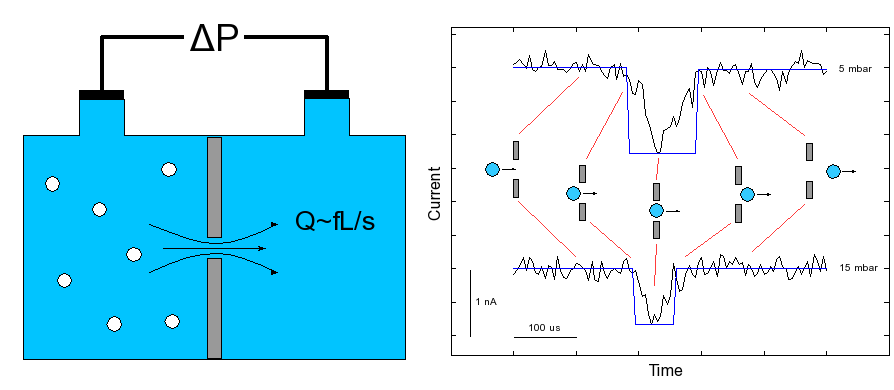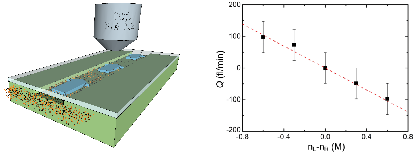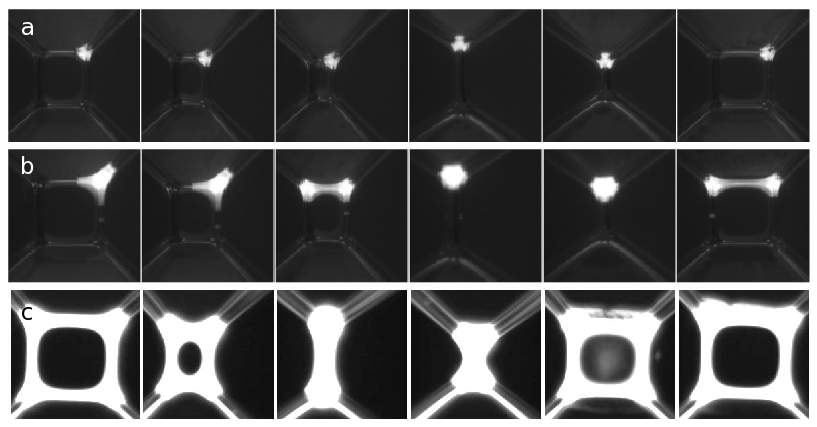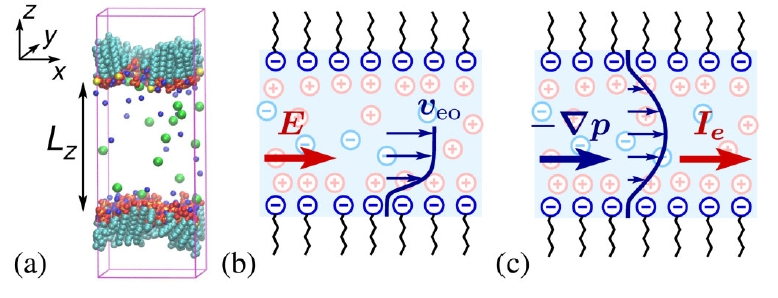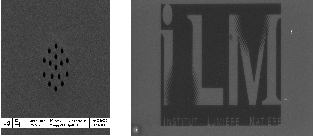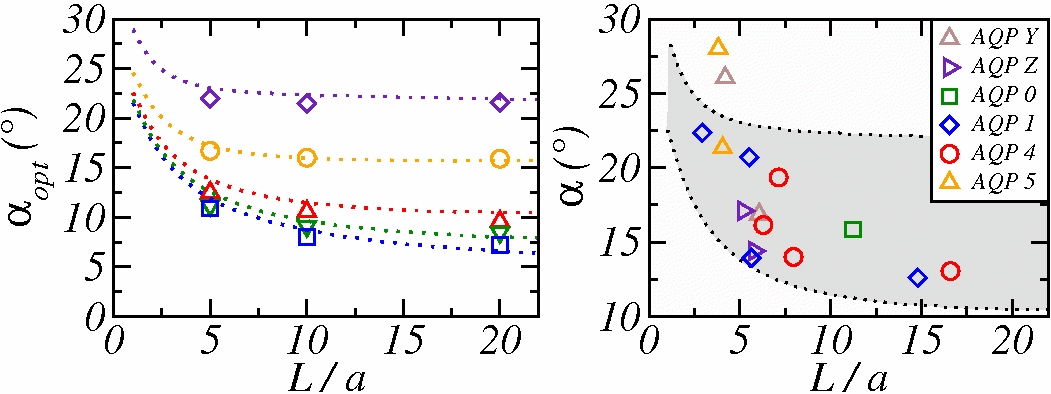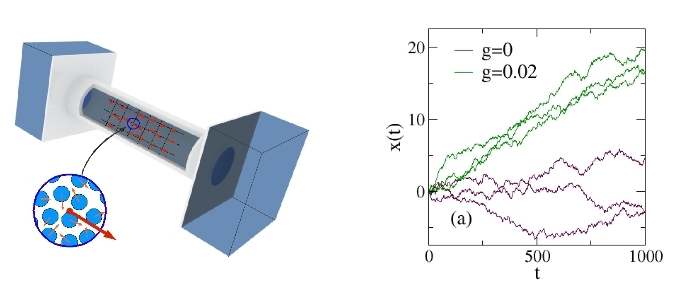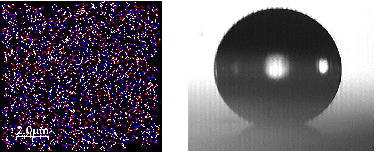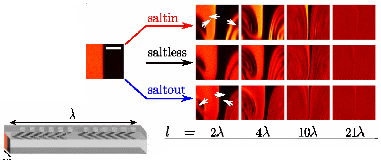More highlights
|
Measuring flow rate with a Coulter counterThe authors designed a technique to measure extremely small flow rates, of the order of a few femto-liters per second. They used the famous Coulter counter technique (1953), aiming at detecting electrically a probe (here a nanobead) blocking partially an orifice. By counting the number of beads going through the pore per second and the dwell time of each bead inside the hole, a hydrodynamic permeability can be measured. Ultra-sensitive flow measurement in individual nanopores...., Gadaleta et al. Nanoscale (2015). |
Mechanism of Coulter counting: each bead passing through the pore induces a drop in the current. |
Osmosis with out a rejecting membraneOsmosis -a liquid flow or a pressure difference induced by concentration differences- is a key phenomenon in cell exchanges, plant mechanics food processing or water desalination. While the usual view of osmosis requires a semi-permeable membrane, we report for the first time an osmotic flow generated without selective channels. The flow in a single nanochannel, could be evidenced using a fluorescence imaging technique with unprecedented resolution. This work could open new ways of manipulating flow at the nanoscale Osmotic flow through fully permeable nanochannels, Lee et al. Phys. Rev. Lett. (2014). |
Flow induced by a concentration gradient in a single non-selective nano-canal. Flow rates are measured through fluorescence microscopy with a resolution of 50fL/min ! |
Oil transport in a soap film architectureA specific soap film architecture has been used to study a fluorescent oil globule transport during a topological rearrangement in a soap film assembly. Depending on oil volume fraction, different regimes have been observed, including one where the transport is favored by the rearrangement process. Collaboration with E. Lorenceau IFFSTAR Oil repartition in a foam film architecture, Piroird et al., Soft Matter (2014) |
|
Anomalous electro-osmosis in foam filmsElectro-osmosis is the flow of liquid induced by an eletric field in the vicinity of a charged interface. In this work, using molecular dynamics simulations, we study this phenomenon at a liquid/air interface covered with charged surfactant molecules, a situation commonly encountered in soap film or foams. In contrast with the traditional case of liquid-solid interface, we find that electro-osmosis remains very efficient, even when there is only a few surfactant molecules. Anomalous zeta potential in foam films, L. Joly et al., Phys. Rev. Lett. (2014). |
(a) Snapshot of a typical simulated system water molecules are not represented. (b)-(c) Sketches of electro-osmosis and streaming current numerical experiments in foam film |
Conductance of an array of nanoporesWe study ionic transport through a regular array of nanopores. Numerous applications use this device, from the sensing of biological molecules to desalination. We show that due to long-range interactions between pores, the conductance is not extensive, with a sub-additive growth with the number of pores. This counter-intuitive behaviour sheds a light on other transport phenomena obeying laplace equations. Sub-additive ionic transport in arrays of solid-state nanopores, Gadaleta et al., Phys. of Fluids (2014). |
(Left) computed stream lines of the electric field around two nanopores. Their deformation is due to electrostatic interactions. (Right) experimental normalized conductance as a function of the number of pores, for a square lattice of nanopores. |
FIB for nanofluidicshe focused ion beam technique has clearly found its place among the more commonly used photo and electron beam lithography as a tool for researchers in the field of nanofluidic. The versatility of this method gives the opportunity to the researchers to create an infinite variety of shapes in the nanoscale range. We hope that we can demonstrate that FIB is and will continue to be among the fabrication techniques in a nanofluidics researcher’s “toolbox”. FIB design for nanofluidic applications, Fulcrand et al., Springer, book chapter (2013). |
(a) Nanopores array etching in a thin silicon nitride membrane (50nm) by using FIB. (b) ILM logo etched on a silicon substrate. |
Aquaporins' shape and permeabilityWe show that it is possible to maximize the hydrodynamic permeability of a hourglass shaped nanochannel for a well chosen opening angle. Strikingly, the predicted optimal angles compare well with the angles measured in a large variety of aquaporins, a protein able to conduct water across cell membranes with a remarkable efficiency. Optimizing water permeability through thehourglass shape of aquaporins, Gravelle et al., PNAS (2013). |
(Left) Angles for which there is an optimisation of the permittivity of a biconical channel according to both theoretical model and simulations. (Right) Measured angles for a large variety of aquaporins. |
Transport in a single nanotube
This study provides characterization of fluidic transport in a single bore-nitride (BN) nanotube, when driven by electric, hydrostatic or or osmotic forces. Experiments suggest that BN nanotubes allow for unprecedented conversion of osmotic power, opening the way to efficient power harvesting of salinity gradients. Giant osmotic energy conversion measured in a single transmembrane boron nitride nanotube, Siria et al, Nature (2013). |
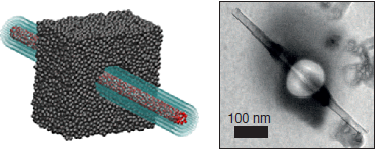
Measurements of fluidic transport in a single Boron-Nitride nanotube inserted in a membrane. Schematic (left) and SEM image of the single nanotube. |
Nanofluidics in a soap filmWe study electrokinetic transport in a soap film of nanometric thickness. Such system is particularly interesting because (i) it is deformable and (ii) the boundary condition is special due to the presence of surfactants. We show that we can obtain an electro-osmotic flow in the soap film, which swells as a consequence. Such process opens the way to long-term stabilization of foams. Soft nanofluidics in a soap film, Bonhomme et al., Phys. Rev. Lett. (2013). |
|
|
|
|
Thermal fluctuations in nanofluidicsThis work investigates the effect of thermal fluctuations on fluid transport in pores of nanometric size. Thermal fluctuations at the molecular scale result in a stochastic flow of the confined fluid, which can be described analytically in the framework of fluctuating hydrodynamics. The consequences discussed for two situations (i) the enhanced diffusion coefficient of a particle within the pore and (ii) a new contribution to electrokinetic noise in charged nanopores. Thermal fluctuations in nanofluidic transport, Detcheverry et al., Phys. Rev. Lett. (2012). |
|
|
Super-oléophobic surfaces We study experimentally the properties of oleophobic and super-oleophobic surfaces nanostructured with fractal patterns. In particular, we discuss the stability of the super-oleophobic regime, the mechanism underlying partial impregnation and the non-existence of homogeneous wetting. Superoleophobic behavior induced by nano- features on oleophilic surfaces. Ramos et al, Langmuir (2010) |
Hexadecane drop on a fractal super-oléophobic surface. |
Chaotic mixingWe explore the consequences of molecular effects on the macroscopic mixing properties of particles: in chaotic or turbulent flow. Even though diffusion phenomena amounts, ultimately, to mixing between strands generated by the flow, the influence of diffusion - and more generally molecular effects - have never been considered for this kind of phenomena. For the case of co-mixing of particles and a molecular solute (salt), we have shown the coupling mechanism - osmotic in nature - between those two passive tracers, and explore the macroscopic consequences. Boosting migration of large particles by solute contrasts. Abecassis et al. Nature Materials (2008).
|
Schematic of the chaotic mixer used (left) and experimental results for co-mixing of fluorescent particles: cross-section after various number of stretching-folding cycles: no co-solute (saltless), salt co-solute with the particles (saltin), or with the mixing solution (saltout). |
|


















